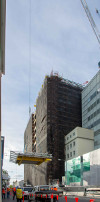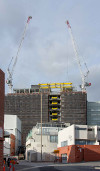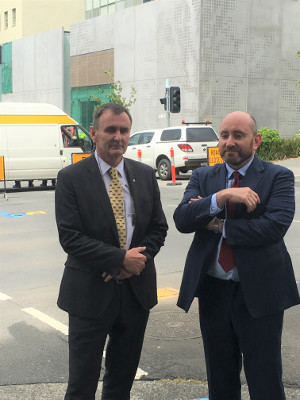A key modular section of the Royal Hobart Hospital’s (RHH) helipad was craned to the roof of K-Block on Saturday, 10 November 2018.
Associate Professor Marcus Skinner, Clinical Director Surgical and Perioperative Services, RHH, and Dr Sandy Zalstein, Director State Trauma Services and Head of Trauma, RHH were interviewed on the importance of the helipad to improving outcomes for patients.
Watch them on Southern Cross News by following this link (@10.08 minutes).
Here’s the abridged transcript edited for print publication.
How important is the helipad installation to the RHH?
“We are trying to bring to zero the number of preventable deaths from trauma,” Dr Skinner said.
“This is of major significance. It’s not just a landing site, it’s a major piece of infrastructure that will give us an enormous amount of capability and improved clinical outcomes for patients by having point to point access,” Dr Skinner said.
Dr Skinner said that the helipad would form a major part of Tasmania’s integrated, statewide management system that would get the right patient to the right facility in the best possible time, to optimise the patient outcomes.
Dr Zalstein said the helipad at the RHH would save lives.
“There are definitely disease processes and injuries for which even small delays contribute to poor outcomes,” Dr Zalstein said.
“Yes, it’s also about patients that have other life threatening major illness that require tertiary level care such as patients who have major vascular problems. Strategically we are now also looking at patients who have stroke and need to have their clots removed urgently,” Dr Skinner added.
The inclusion of the helipad in the K-Block scope was a recommendation of the 2014 RHH Redevelopment Rescue Taskforce.
“Tasmania was at risk of being an outlier, we were at risk of not having the means to support current best practice and current best standards of care and the helipad lets us do that for trauma and for a lot of other time critical illnesses,” Dr Zalstein said.
“We were so pleased that the Minister took the opportunity to include a helipad in the K-Block design and to address that shortfall.”
Dr Skinner added that the secondary benefit would be that aeromedical retrievals would be more efficient.
“At the moment we have duplication because we have to move patients out of a helicopter on the Domain, into an ambulance and then bring them to the hospital,” Dr Skinner said.
“With the helipad we will be able to bring them directly to the hospital and the resources we’ve needed to transfer patients on the ground from the helicopter can be used for their primary purpose, on the road.”
What do you mean by trauma?
“A good example would be patients who have major head injury or patients who have multi-trauma with multiple parts of the body being injured for example in a motor vehicle accident with head, chest, abdominal and major orthopaedic injuries,” Dr Skinner said.
Tasmania has around 250 major trauma cases per annum or just over one very two days. They are patients who meet the national criteria for trauma that is, who without tertiary level care have a high likelihood of dying from their injuries.
Who will benefit from the helipad?
“The patients who will most benefit are less likely to be the people who live in Hobart but the people outside Hobart, tourists who come to Tasmania, and those people who are severely injured,” Dr Skinner said.
Can you tell us about the design of the helipad?






“I’m satisfied that the design of this helipad is state-of-the-art, it has been correctly specified, it’s fit-for-purpose,” Dr Zalstein said.
“I can only commend the level of professionalism and engagement of Redevelopment team with keeping clinicians involved and managing the process after the funding was released.
Dr Zalstein said that the helipad had been extremely well procured and managed and that he was looking forward to the commissioning and getting it up and running.
“I have to admit for Marcus and me it’s a real privilege to be part of the process.
“I’m very comfortable, in fact I’m more than comfortable, I’m delighted to see the Redevelopment team managing it so well,” he said.
How long have you been advocating for a helipad at the RHH?
“I graduated in Tasmania, here in Hobart in 1984 and as an intern here in 1985 we were aware then that we needed a much better trauma system in Tasmania. It’s taken a long time to get here but we appreciate Minister Ferguson taking on the challenge that we presented to him in 2014 to make sure that a helipad was included in this rebuilt facility,” Dr Skinner said.
“Marcus and I made representations to the then new Minister in 2014 and it was recognised as an opportunity to invest in critical state infrastructure that had been overlooked previously,” Dr Zalstein said.
When will the helipad be able to be used?
“It’s got to go through the correct checks and balances and it’s got to be commissioned for hospital operations then we’ve got to open it up for flight operations, so there’s a number of checks and balances and milestones we’ve got to meet,” he said.
K-Block is scheduled to reach practical completion mid-2019 with operational commissioning of the building including the helipad to follow in subsequent months.
19 Nov 2018











